Case Study: Analysis of Labour Demand and Supply for Petronas (MM-333)
VerifiedAdded on 2023/01/13
|9
|2352
|73
Case Study
AI Summary
This case study examines the labour dynamics within Petronas, a major Malaysian oil and gas company. It analyzes critical factors influencing labour demand, such as skill gaps, research and development investment, and the impact of foreign labour. The study also explores issues affecting labour supply, including economic crises, wage levels, and the need for skilled workers. Furthermore, it identifies the challenges Petronas faces in attracting and retaining its workforce, including competition for skilled workers and the impact of economic downturns. The case study emphasizes the importance of workforce changes and their impact on existing and future jobs, and the need for strategic adjustments to address labour market challenges. The conclusion highlights key findings and suggests strategies for generating labour demand and supply within the organization.
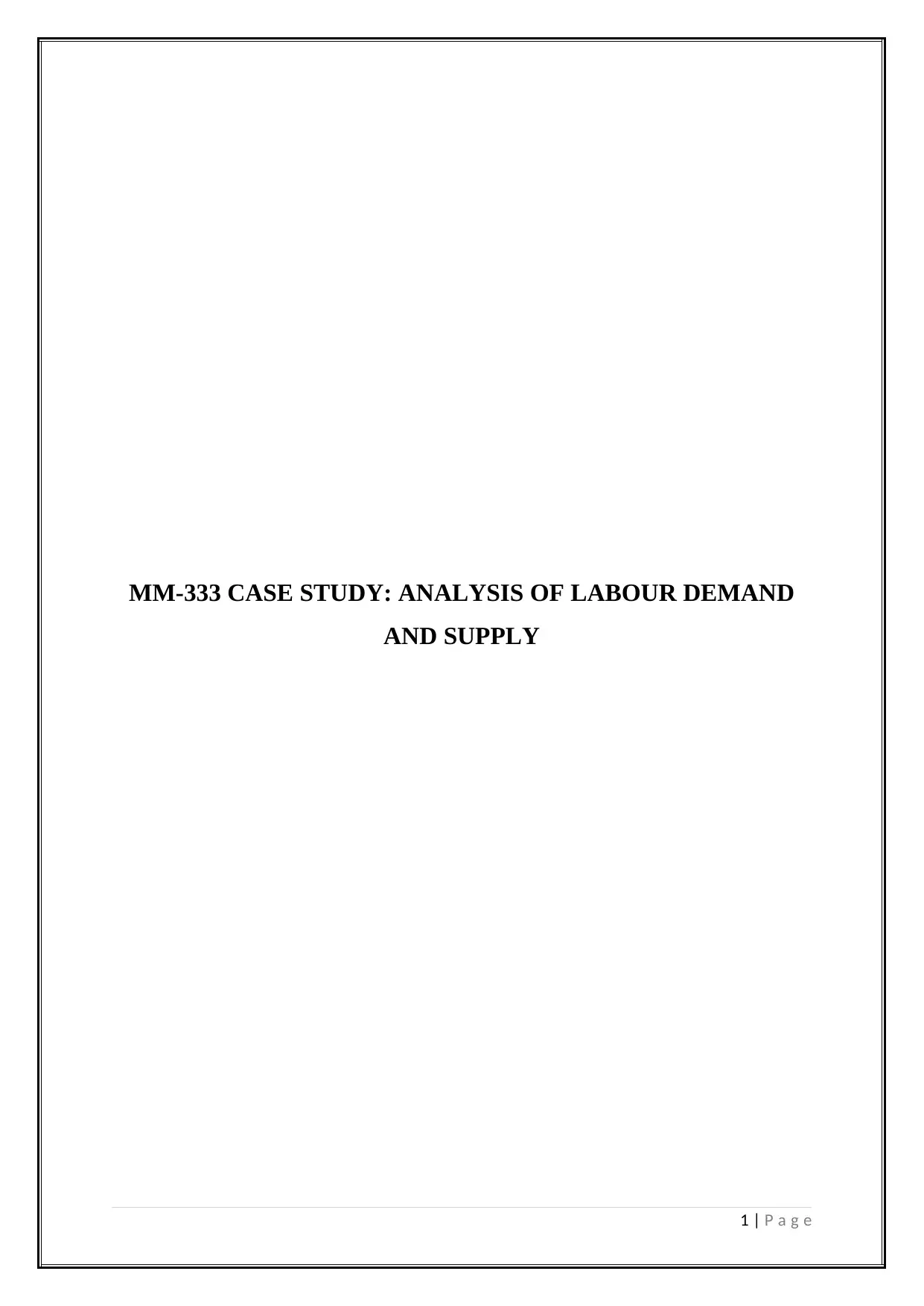
MM-333 CASE STUDY: ANALYSIS OF LABOUR DEMAND
AND SUPPLY
1 | P a g e
AND SUPPLY
1 | P a g e
Paraphrase This Document
Need a fresh take? Get an instant paraphrase of this document with our AI Paraphraser
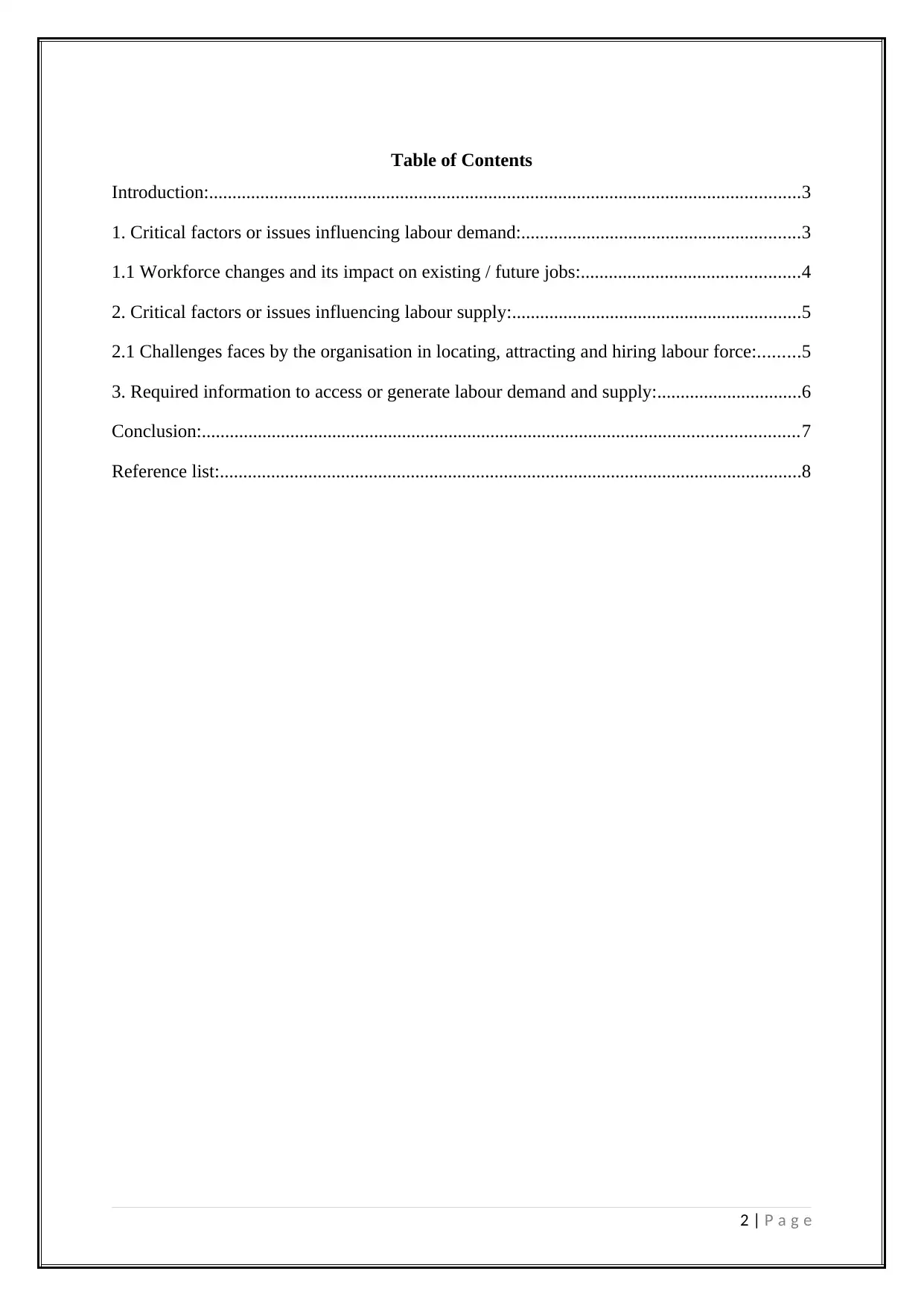
Table of Contents
Introduction:...............................................................................................................................3
1. Critical factors or issues influencing labour demand:............................................................3
1.1 Workforce changes and its impact on existing / future jobs:...............................................4
2. Critical factors or issues influencing labour supply:..............................................................5
2.1 Challenges faces by the organisation in locating, attracting and hiring labour force:.........5
3. Required information to access or generate labour demand and supply:...............................6
Conclusion:................................................................................................................................7
Reference list:.............................................................................................................................8
2 | P a g e
Introduction:...............................................................................................................................3
1. Critical factors or issues influencing labour demand:............................................................3
1.1 Workforce changes and its impact on existing / future jobs:...............................................4
2. Critical factors or issues influencing labour supply:..............................................................5
2.1 Challenges faces by the organisation in locating, attracting and hiring labour force:.........5
3. Required information to access or generate labour demand and supply:...............................6
Conclusion:................................................................................................................................7
Reference list:.............................................................................................................................8
2 | P a g e
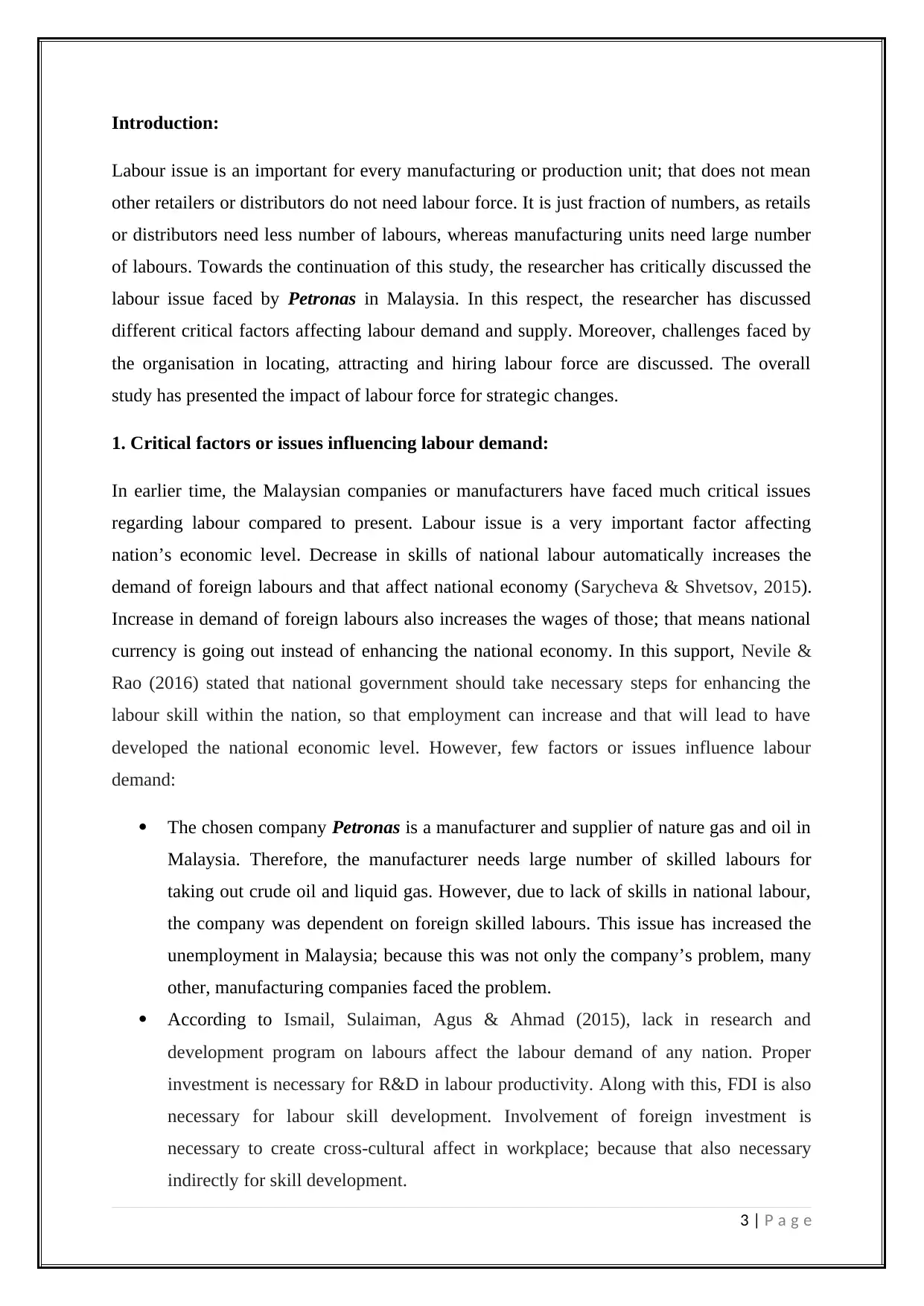
Introduction:
Labour issue is an important for every manufacturing or production unit; that does not mean
other retailers or distributors do not need labour force. It is just fraction of numbers, as retails
or distributors need less number of labours, whereas manufacturing units need large number
of labours. Towards the continuation of this study, the researcher has critically discussed the
labour issue faced by Petronas in Malaysia. In this respect, the researcher has discussed
different critical factors affecting labour demand and supply. Moreover, challenges faced by
the organisation in locating, attracting and hiring labour force are discussed. The overall
study has presented the impact of labour force for strategic changes.
1. Critical factors or issues influencing labour demand:
In earlier time, the Malaysian companies or manufacturers have faced much critical issues
regarding labour compared to present. Labour issue is a very important factor affecting
nation’s economic level. Decrease in skills of national labour automatically increases the
demand of foreign labours and that affect national economy (Sarycheva & Shvetsov, 2015).
Increase in demand of foreign labours also increases the wages of those; that means national
currency is going out instead of enhancing the national economy. In this support, Nevile &
Rao (2016) stated that national government should take necessary steps for enhancing the
labour skill within the nation, so that employment can increase and that will lead to have
developed the national economic level. However, few factors or issues influence labour
demand:
The chosen company Petronas is a manufacturer and supplier of nature gas and oil in
Malaysia. Therefore, the manufacturer needs large number of skilled labours for
taking out crude oil and liquid gas. However, due to lack of skills in national labour,
the company was dependent on foreign skilled labours. This issue has increased the
unemployment in Malaysia; because this was not only the company’s problem, many
other, manufacturing companies faced the problem.
According to Ismail, Sulaiman, Agus & Ahmad (2015), lack in research and
development program on labours affect the labour demand of any nation. Proper
investment is necessary for R&D in labour productivity. Along with this, FDI is also
necessary for labour skill development. Involvement of foreign investment is
necessary to create cross-cultural affect in workplace; because that also necessary
indirectly for skill development.
3 | P a g e
Labour issue is an important for every manufacturing or production unit; that does not mean
other retailers or distributors do not need labour force. It is just fraction of numbers, as retails
or distributors need less number of labours, whereas manufacturing units need large number
of labours. Towards the continuation of this study, the researcher has critically discussed the
labour issue faced by Petronas in Malaysia. In this respect, the researcher has discussed
different critical factors affecting labour demand and supply. Moreover, challenges faced by
the organisation in locating, attracting and hiring labour force are discussed. The overall
study has presented the impact of labour force for strategic changes.
1. Critical factors or issues influencing labour demand:
In earlier time, the Malaysian companies or manufacturers have faced much critical issues
regarding labour compared to present. Labour issue is a very important factor affecting
nation’s economic level. Decrease in skills of national labour automatically increases the
demand of foreign labours and that affect national economy (Sarycheva & Shvetsov, 2015).
Increase in demand of foreign labours also increases the wages of those; that means national
currency is going out instead of enhancing the national economy. In this support, Nevile &
Rao (2016) stated that national government should take necessary steps for enhancing the
labour skill within the nation, so that employment can increase and that will lead to have
developed the national economic level. However, few factors or issues influence labour
demand:
The chosen company Petronas is a manufacturer and supplier of nature gas and oil in
Malaysia. Therefore, the manufacturer needs large number of skilled labours for
taking out crude oil and liquid gas. However, due to lack of skills in national labour,
the company was dependent on foreign skilled labours. This issue has increased the
unemployment in Malaysia; because this was not only the company’s problem, many
other, manufacturing companies faced the problem.
According to Ismail, Sulaiman, Agus & Ahmad (2015), lack in research and
development program on labours affect the labour demand of any nation. Proper
investment is necessary for R&D in labour productivity. Along with this, FDI is also
necessary for labour skill development. Involvement of foreign investment is
necessary to create cross-cultural affect in workplace; because that also necessary
indirectly for skill development.
3 | P a g e
⊘ This is a preview!⊘
Do you want full access?
Subscribe today to unlock all pages.

Trusted by 1+ million students worldwide
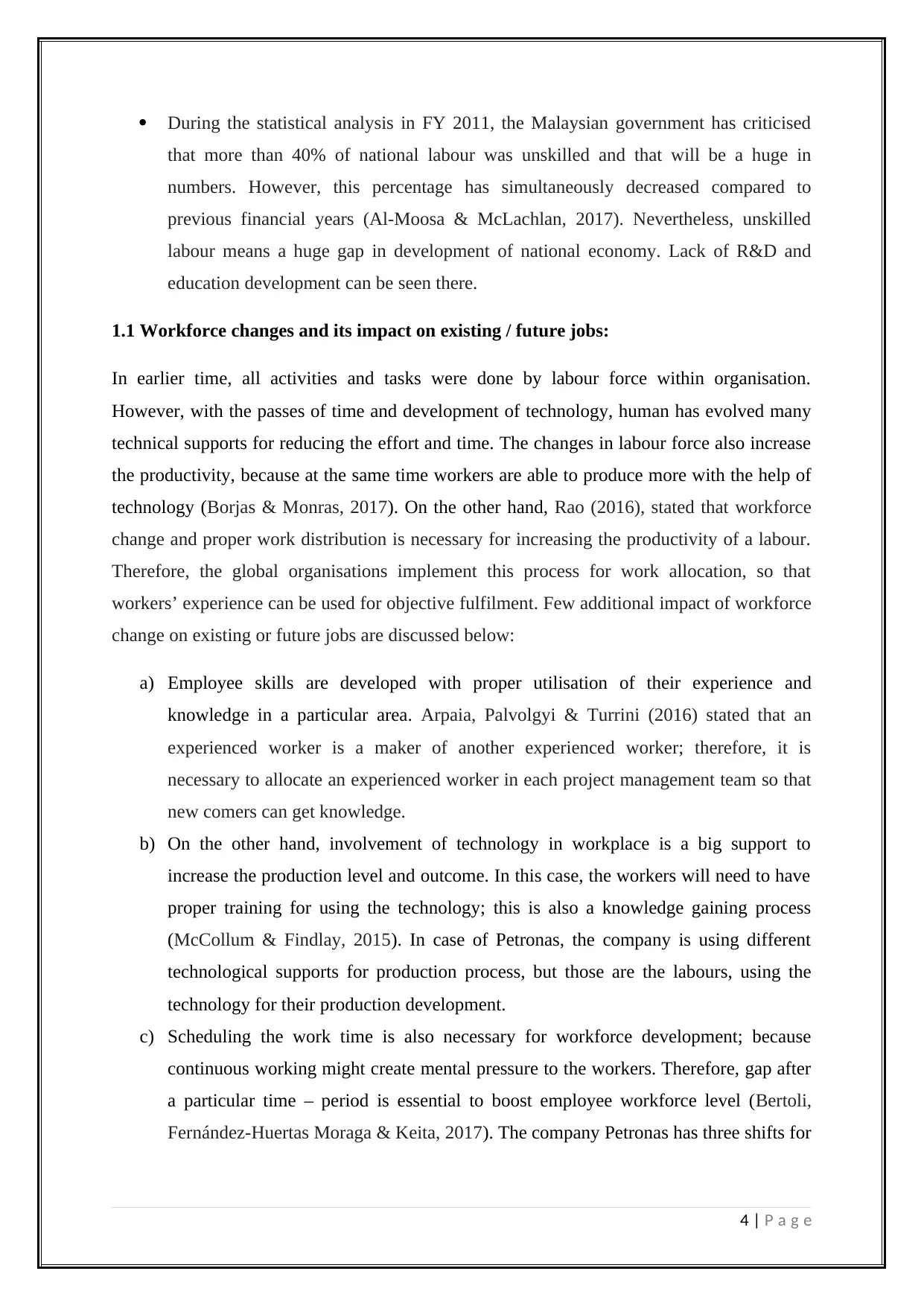
During the statistical analysis in FY 2011, the Malaysian government has criticised
that more than 40% of national labour was unskilled and that will be a huge in
numbers. However, this percentage has simultaneously decreased compared to
previous financial years (Al-Moosa & McLachlan, 2017). Nevertheless, unskilled
labour means a huge gap in development of national economy. Lack of R&D and
education development can be seen there.
1.1 Workforce changes and its impact on existing / future jobs:
In earlier time, all activities and tasks were done by labour force within organisation.
However, with the passes of time and development of technology, human has evolved many
technical supports for reducing the effort and time. The changes in labour force also increase
the productivity, because at the same time workers are able to produce more with the help of
technology (Borjas & Monras, 2017). On the other hand, Rao (2016), stated that workforce
change and proper work distribution is necessary for increasing the productivity of a labour.
Therefore, the global organisations implement this process for work allocation, so that
workers’ experience can be used for objective fulfilment. Few additional impact of workforce
change on existing or future jobs are discussed below:
a) Employee skills are developed with proper utilisation of their experience and
knowledge in a particular area. Arpaia, Palvolgyi & Turrini (2016) stated that an
experienced worker is a maker of another experienced worker; therefore, it is
necessary to allocate an experienced worker in each project management team so that
new comers can get knowledge.
b) On the other hand, involvement of technology in workplace is a big support to
increase the production level and outcome. In this case, the workers will need to have
proper training for using the technology; this is also a knowledge gaining process
(McCollum & Findlay, 2015). In case of Petronas, the company is using different
technological supports for production process, but those are the labours, using the
technology for their production development.
c) Scheduling the work time is also necessary for workforce development; because
continuous working might create mental pressure to the workers. Therefore, gap after
a particular time – period is essential to boost employee workforce level (Bertoli,
Fernández-Huertas Moraga & Keita, 2017). The company Petronas has three shifts for
4 | P a g e
that more than 40% of national labour was unskilled and that will be a huge in
numbers. However, this percentage has simultaneously decreased compared to
previous financial years (Al-Moosa & McLachlan, 2017). Nevertheless, unskilled
labour means a huge gap in development of national economy. Lack of R&D and
education development can be seen there.
1.1 Workforce changes and its impact on existing / future jobs:
In earlier time, all activities and tasks were done by labour force within organisation.
However, with the passes of time and development of technology, human has evolved many
technical supports for reducing the effort and time. The changes in labour force also increase
the productivity, because at the same time workers are able to produce more with the help of
technology (Borjas & Monras, 2017). On the other hand, Rao (2016), stated that workforce
change and proper work distribution is necessary for increasing the productivity of a labour.
Therefore, the global organisations implement this process for work allocation, so that
workers’ experience can be used for objective fulfilment. Few additional impact of workforce
change on existing or future jobs are discussed below:
a) Employee skills are developed with proper utilisation of their experience and
knowledge in a particular area. Arpaia, Palvolgyi & Turrini (2016) stated that an
experienced worker is a maker of another experienced worker; therefore, it is
necessary to allocate an experienced worker in each project management team so that
new comers can get knowledge.
b) On the other hand, involvement of technology in workplace is a big support to
increase the production level and outcome. In this case, the workers will need to have
proper training for using the technology; this is also a knowledge gaining process
(McCollum & Findlay, 2015). In case of Petronas, the company is using different
technological supports for production process, but those are the labours, using the
technology for their production development.
c) Scheduling the work time is also necessary for workforce development; because
continuous working might create mental pressure to the workers. Therefore, gap after
a particular time – period is essential to boost employee workforce level (Bertoli,
Fernández-Huertas Moraga & Keita, 2017). The company Petronas has three shifts for
4 | P a g e
Paraphrase This Document
Need a fresh take? Get an instant paraphrase of this document with our AI Paraphraser
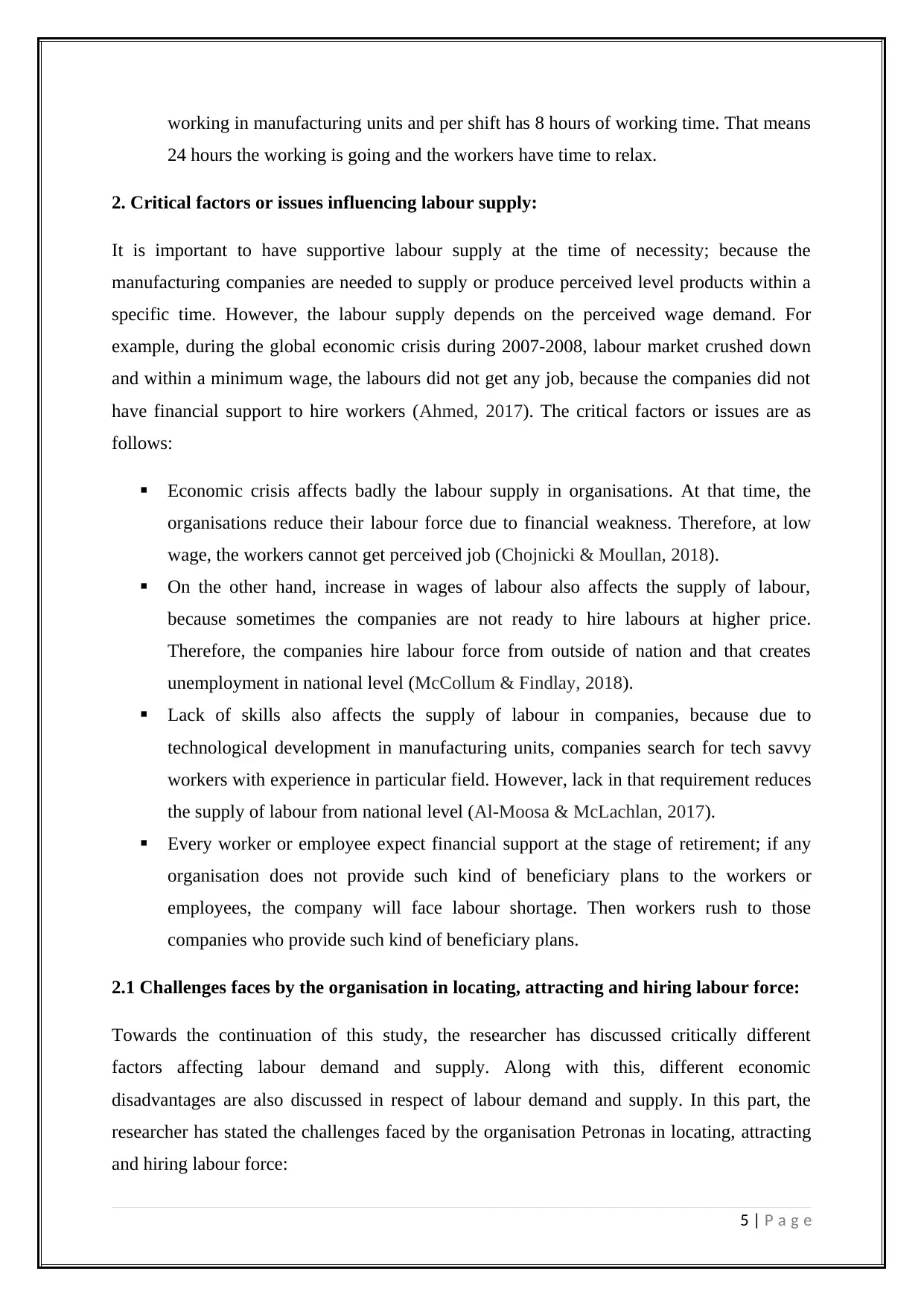
working in manufacturing units and per shift has 8 hours of working time. That means
24 hours the working is going and the workers have time to relax.
2. Critical factors or issues influencing labour supply:
It is important to have supportive labour supply at the time of necessity; because the
manufacturing companies are needed to supply or produce perceived level products within a
specific time. However, the labour supply depends on the perceived wage demand. For
example, during the global economic crisis during 2007-2008, labour market crushed down
and within a minimum wage, the labours did not get any job, because the companies did not
have financial support to hire workers (Ahmed, 2017). The critical factors or issues are as
follows:
Economic crisis affects badly the labour supply in organisations. At that time, the
organisations reduce their labour force due to financial weakness. Therefore, at low
wage, the workers cannot get perceived job (Chojnicki & Moullan, 2018).
On the other hand, increase in wages of labour also affects the supply of labour,
because sometimes the companies are not ready to hire labours at higher price.
Therefore, the companies hire labour force from outside of nation and that creates
unemployment in national level (McCollum & Findlay, 2018).
Lack of skills also affects the supply of labour in companies, because due to
technological development in manufacturing units, companies search for tech savvy
workers with experience in particular field. However, lack in that requirement reduces
the supply of labour from national level (Al-Moosa & McLachlan, 2017).
Every worker or employee expect financial support at the stage of retirement; if any
organisation does not provide such kind of beneficiary plans to the workers or
employees, the company will face labour shortage. Then workers rush to those
companies who provide such kind of beneficiary plans.
2.1 Challenges faces by the organisation in locating, attracting and hiring labour force:
Towards the continuation of this study, the researcher has discussed critically different
factors affecting labour demand and supply. Along with this, different economic
disadvantages are also discussed in respect of labour demand and supply. In this part, the
researcher has stated the challenges faced by the organisation Petronas in locating, attracting
and hiring labour force:
5 | P a g e
24 hours the working is going and the workers have time to relax.
2. Critical factors or issues influencing labour supply:
It is important to have supportive labour supply at the time of necessity; because the
manufacturing companies are needed to supply or produce perceived level products within a
specific time. However, the labour supply depends on the perceived wage demand. For
example, during the global economic crisis during 2007-2008, labour market crushed down
and within a minimum wage, the labours did not get any job, because the companies did not
have financial support to hire workers (Ahmed, 2017). The critical factors or issues are as
follows:
Economic crisis affects badly the labour supply in organisations. At that time, the
organisations reduce their labour force due to financial weakness. Therefore, at low
wage, the workers cannot get perceived job (Chojnicki & Moullan, 2018).
On the other hand, increase in wages of labour also affects the supply of labour,
because sometimes the companies are not ready to hire labours at higher price.
Therefore, the companies hire labour force from outside of nation and that creates
unemployment in national level (McCollum & Findlay, 2018).
Lack of skills also affects the supply of labour in companies, because due to
technological development in manufacturing units, companies search for tech savvy
workers with experience in particular field. However, lack in that requirement reduces
the supply of labour from national level (Al-Moosa & McLachlan, 2017).
Every worker or employee expect financial support at the stage of retirement; if any
organisation does not provide such kind of beneficiary plans to the workers or
employees, the company will face labour shortage. Then workers rush to those
companies who provide such kind of beneficiary plans.
2.1 Challenges faces by the organisation in locating, attracting and hiring labour force:
Towards the continuation of this study, the researcher has discussed critically different
factors affecting labour demand and supply. Along with this, different economic
disadvantages are also discussed in respect of labour demand and supply. In this part, the
researcher has stated the challenges faced by the organisation Petronas in locating, attracting
and hiring labour force:
5 | P a g e
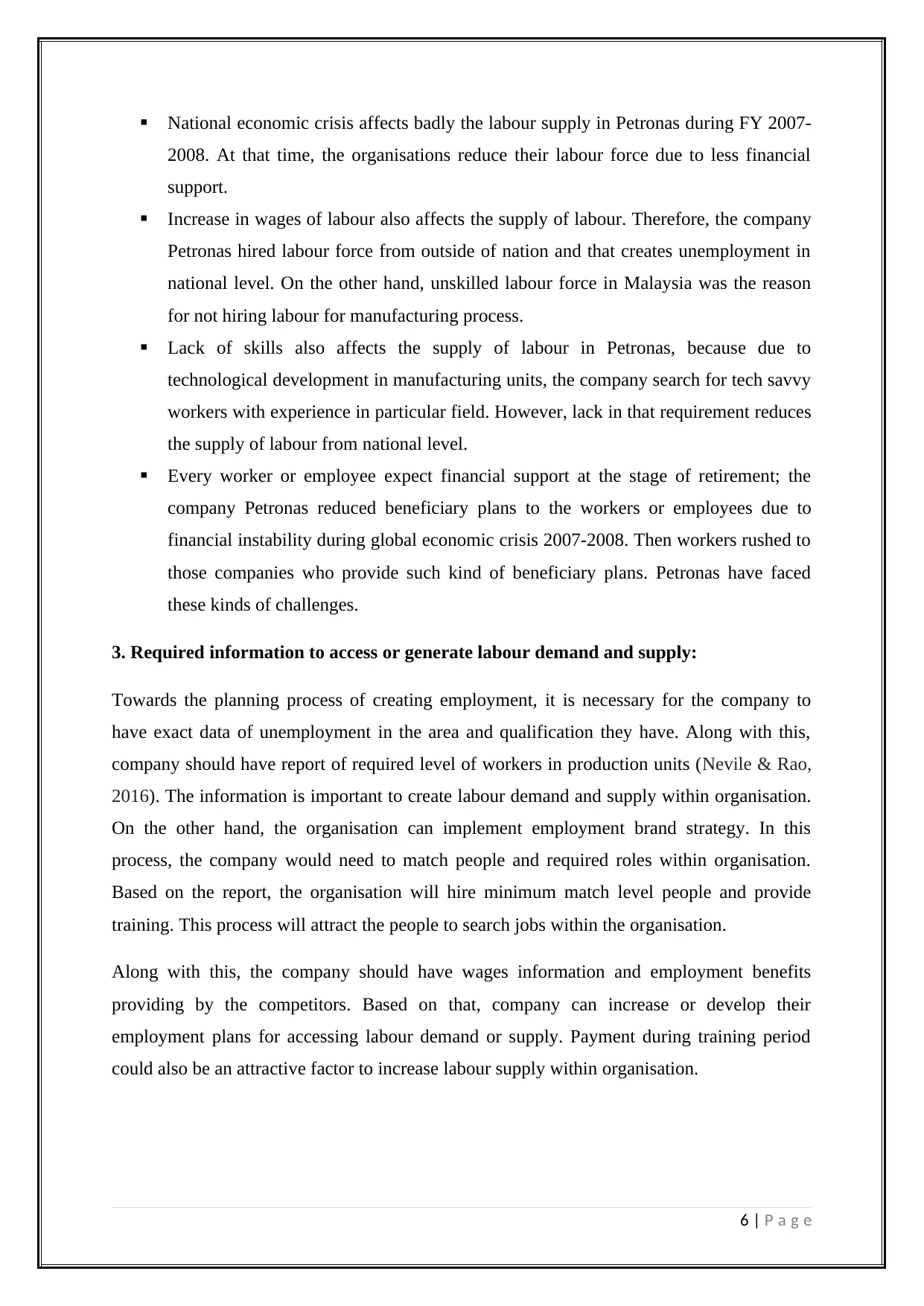
National economic crisis affects badly the labour supply in Petronas during FY 2007-
2008. At that time, the organisations reduce their labour force due to less financial
support.
Increase in wages of labour also affects the supply of labour. Therefore, the company
Petronas hired labour force from outside of nation and that creates unemployment in
national level. On the other hand, unskilled labour force in Malaysia was the reason
for not hiring labour for manufacturing process.
Lack of skills also affects the supply of labour in Petronas, because due to
technological development in manufacturing units, the company search for tech savvy
workers with experience in particular field. However, lack in that requirement reduces
the supply of labour from national level.
Every worker or employee expect financial support at the stage of retirement; the
company Petronas reduced beneficiary plans to the workers or employees due to
financial instability during global economic crisis 2007-2008. Then workers rushed to
those companies who provide such kind of beneficiary plans. Petronas have faced
these kinds of challenges.
3. Required information to access or generate labour demand and supply:
Towards the planning process of creating employment, it is necessary for the company to
have exact data of unemployment in the area and qualification they have. Along with this,
company should have report of required level of workers in production units (Nevile & Rao,
2016). The information is important to create labour demand and supply within organisation.
On the other hand, the organisation can implement employment brand strategy. In this
process, the company would need to match people and required roles within organisation.
Based on the report, the organisation will hire minimum match level people and provide
training. This process will attract the people to search jobs within the organisation.
Along with this, the company should have wages information and employment benefits
providing by the competitors. Based on that, company can increase or develop their
employment plans for accessing labour demand or supply. Payment during training period
could also be an attractive factor to increase labour supply within organisation.
6 | P a g e
2008. At that time, the organisations reduce their labour force due to less financial
support.
Increase in wages of labour also affects the supply of labour. Therefore, the company
Petronas hired labour force from outside of nation and that creates unemployment in
national level. On the other hand, unskilled labour force in Malaysia was the reason
for not hiring labour for manufacturing process.
Lack of skills also affects the supply of labour in Petronas, because due to
technological development in manufacturing units, the company search for tech savvy
workers with experience in particular field. However, lack in that requirement reduces
the supply of labour from national level.
Every worker or employee expect financial support at the stage of retirement; the
company Petronas reduced beneficiary plans to the workers or employees due to
financial instability during global economic crisis 2007-2008. Then workers rushed to
those companies who provide such kind of beneficiary plans. Petronas have faced
these kinds of challenges.
3. Required information to access or generate labour demand and supply:
Towards the planning process of creating employment, it is necessary for the company to
have exact data of unemployment in the area and qualification they have. Along with this,
company should have report of required level of workers in production units (Nevile & Rao,
2016). The information is important to create labour demand and supply within organisation.
On the other hand, the organisation can implement employment brand strategy. In this
process, the company would need to match people and required roles within organisation.
Based on the report, the organisation will hire minimum match level people and provide
training. This process will attract the people to search jobs within the organisation.
Along with this, the company should have wages information and employment benefits
providing by the competitors. Based on that, company can increase or develop their
employment plans for accessing labour demand or supply. Payment during training period
could also be an attractive factor to increase labour supply within organisation.
6 | P a g e
⊘ This is a preview!⊘
Do you want full access?
Subscribe today to unlock all pages.

Trusted by 1+ million students worldwide
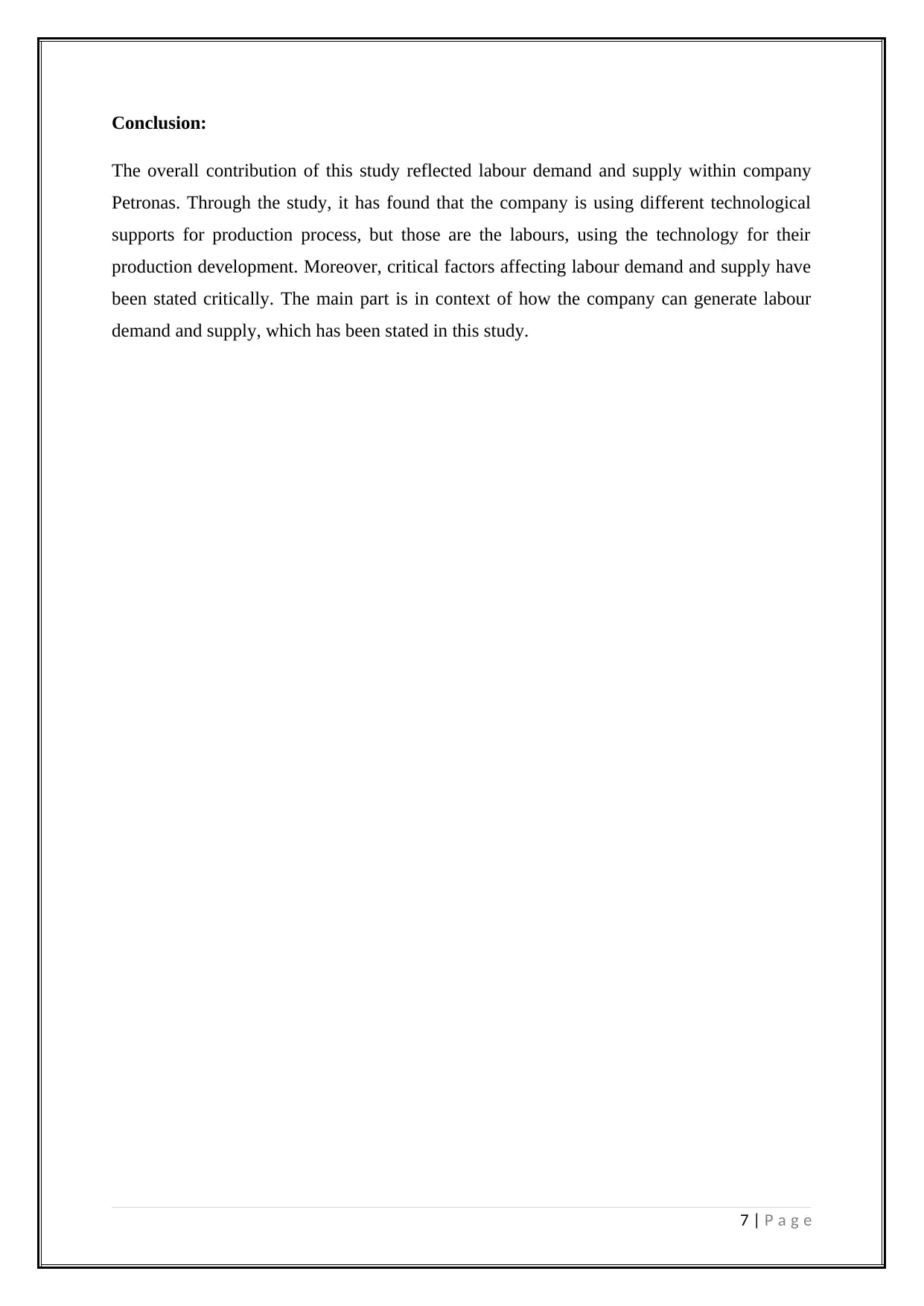
Conclusion:
The overall contribution of this study reflected labour demand and supply within company
Petronas. Through the study, it has found that the company is using different technological
supports for production process, but those are the labours, using the technology for their
production development. Moreover, critical factors affecting labour demand and supply have
been stated critically. The main part is in context of how the company can generate labour
demand and supply, which has been stated in this study.
7 | P a g e
The overall contribution of this study reflected labour demand and supply within company
Petronas. Through the study, it has found that the company is using different technological
supports for production process, but those are the labours, using the technology for their
production development. Moreover, critical factors affecting labour demand and supply have
been stated critically. The main part is in context of how the company can generate labour
demand and supply, which has been stated in this study.
7 | P a g e
Paraphrase This Document
Need a fresh take? Get an instant paraphrase of this document with our AI Paraphraser
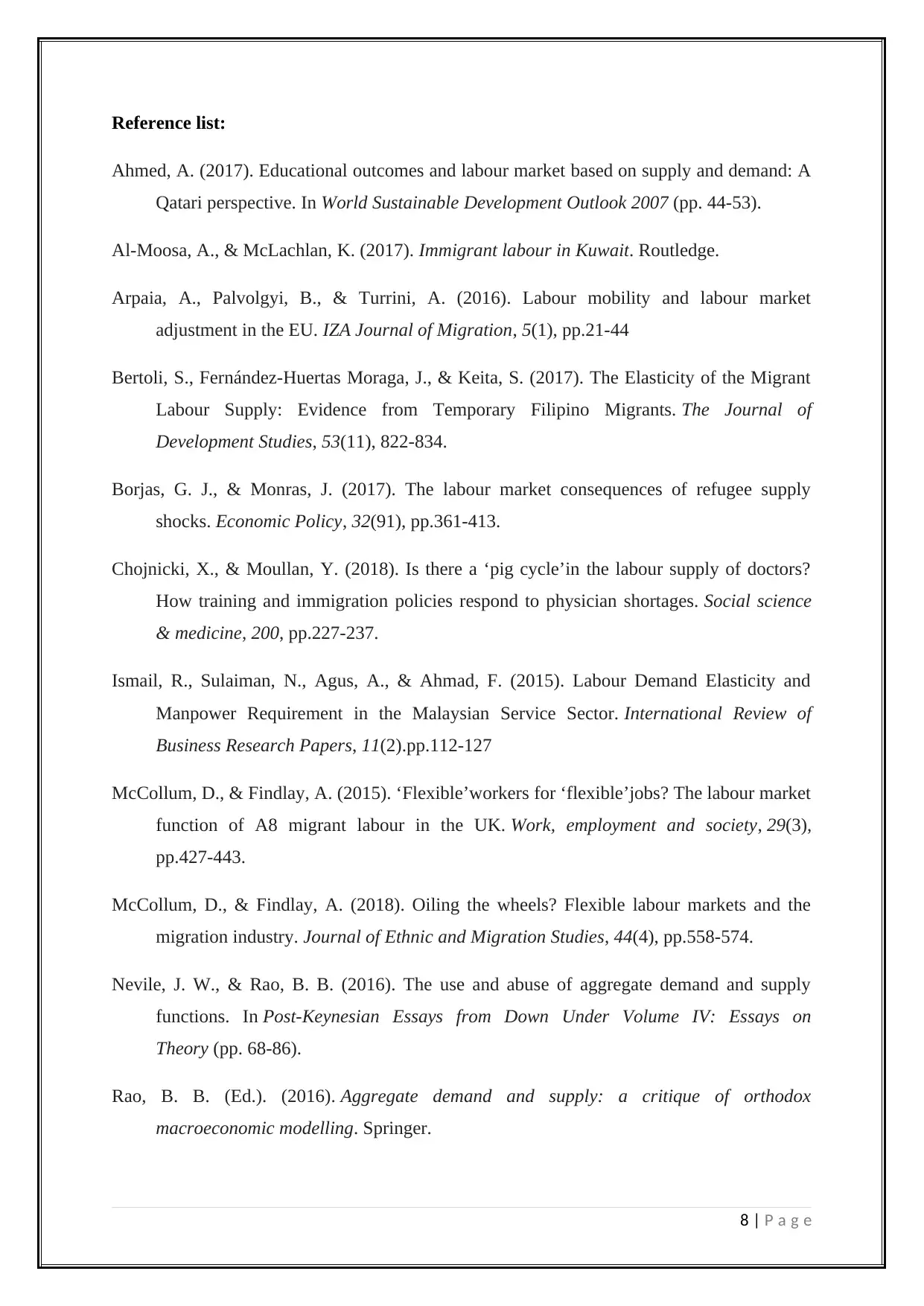
Reference list:
Ahmed, A. (2017). Educational outcomes and labour market based on supply and demand: A
Qatari perspective. In World Sustainable Development Outlook 2007 (pp. 44-53).
Al-Moosa, A., & McLachlan, K. (2017). Immigrant labour in Kuwait. Routledge.
Arpaia, A., Palvolgyi, B., & Turrini, A. (2016). Labour mobility and labour market
adjustment in the EU. IZA Journal of Migration, 5(1), pp.21-44
Bertoli, S., Fernández-Huertas Moraga, J., & Keita, S. (2017). The Elasticity of the Migrant
Labour Supply: Evidence from Temporary Filipino Migrants. The Journal of
Development Studies, 53(11), 822-834.
Borjas, G. J., & Monras, J. (2017). The labour market consequences of refugee supply
shocks. Economic Policy, 32(91), pp.361-413.
Chojnicki, X., & Moullan, Y. (2018). Is there a ‘pig cycle’in the labour supply of doctors?
How training and immigration policies respond to physician shortages. Social science
& medicine, 200, pp.227-237.
Ismail, R., Sulaiman, N., Agus, A., & Ahmad, F. (2015). Labour Demand Elasticity and
Manpower Requirement in the Malaysian Service Sector. International Review of
Business Research Papers, 11(2).pp.112-127
McCollum, D., & Findlay, A. (2015). ‘Flexible’workers for ‘flexible’jobs? The labour market
function of A8 migrant labour in the UK. Work, employment and society, 29(3),
pp.427-443.
McCollum, D., & Findlay, A. (2018). Oiling the wheels? Flexible labour markets and the
migration industry. Journal of Ethnic and Migration Studies, 44(4), pp.558-574.
Nevile, J. W., & Rao, B. B. (2016). The use and abuse of aggregate demand and supply
functions. In Post-Keynesian Essays from Down Under Volume IV: Essays on
Theory (pp. 68-86).
Rao, B. B. (Ed.). (2016). Aggregate demand and supply: a critique of orthodox
macroeconomic modelling. Springer.
8 | P a g e
Ahmed, A. (2017). Educational outcomes and labour market based on supply and demand: A
Qatari perspective. In World Sustainable Development Outlook 2007 (pp. 44-53).
Al-Moosa, A., & McLachlan, K. (2017). Immigrant labour in Kuwait. Routledge.
Arpaia, A., Palvolgyi, B., & Turrini, A. (2016). Labour mobility and labour market
adjustment in the EU. IZA Journal of Migration, 5(1), pp.21-44
Bertoli, S., Fernández-Huertas Moraga, J., & Keita, S. (2017). The Elasticity of the Migrant
Labour Supply: Evidence from Temporary Filipino Migrants. The Journal of
Development Studies, 53(11), 822-834.
Borjas, G. J., & Monras, J. (2017). The labour market consequences of refugee supply
shocks. Economic Policy, 32(91), pp.361-413.
Chojnicki, X., & Moullan, Y. (2018). Is there a ‘pig cycle’in the labour supply of doctors?
How training and immigration policies respond to physician shortages. Social science
& medicine, 200, pp.227-237.
Ismail, R., Sulaiman, N., Agus, A., & Ahmad, F. (2015). Labour Demand Elasticity and
Manpower Requirement in the Malaysian Service Sector. International Review of
Business Research Papers, 11(2).pp.112-127
McCollum, D., & Findlay, A. (2015). ‘Flexible’workers for ‘flexible’jobs? The labour market
function of A8 migrant labour in the UK. Work, employment and society, 29(3),
pp.427-443.
McCollum, D., & Findlay, A. (2018). Oiling the wheels? Flexible labour markets and the
migration industry. Journal of Ethnic and Migration Studies, 44(4), pp.558-574.
Nevile, J. W., & Rao, B. B. (2016). The use and abuse of aggregate demand and supply
functions. In Post-Keynesian Essays from Down Under Volume IV: Essays on
Theory (pp. 68-86).
Rao, B. B. (Ed.). (2016). Aggregate demand and supply: a critique of orthodox
macroeconomic modelling. Springer.
8 | P a g e
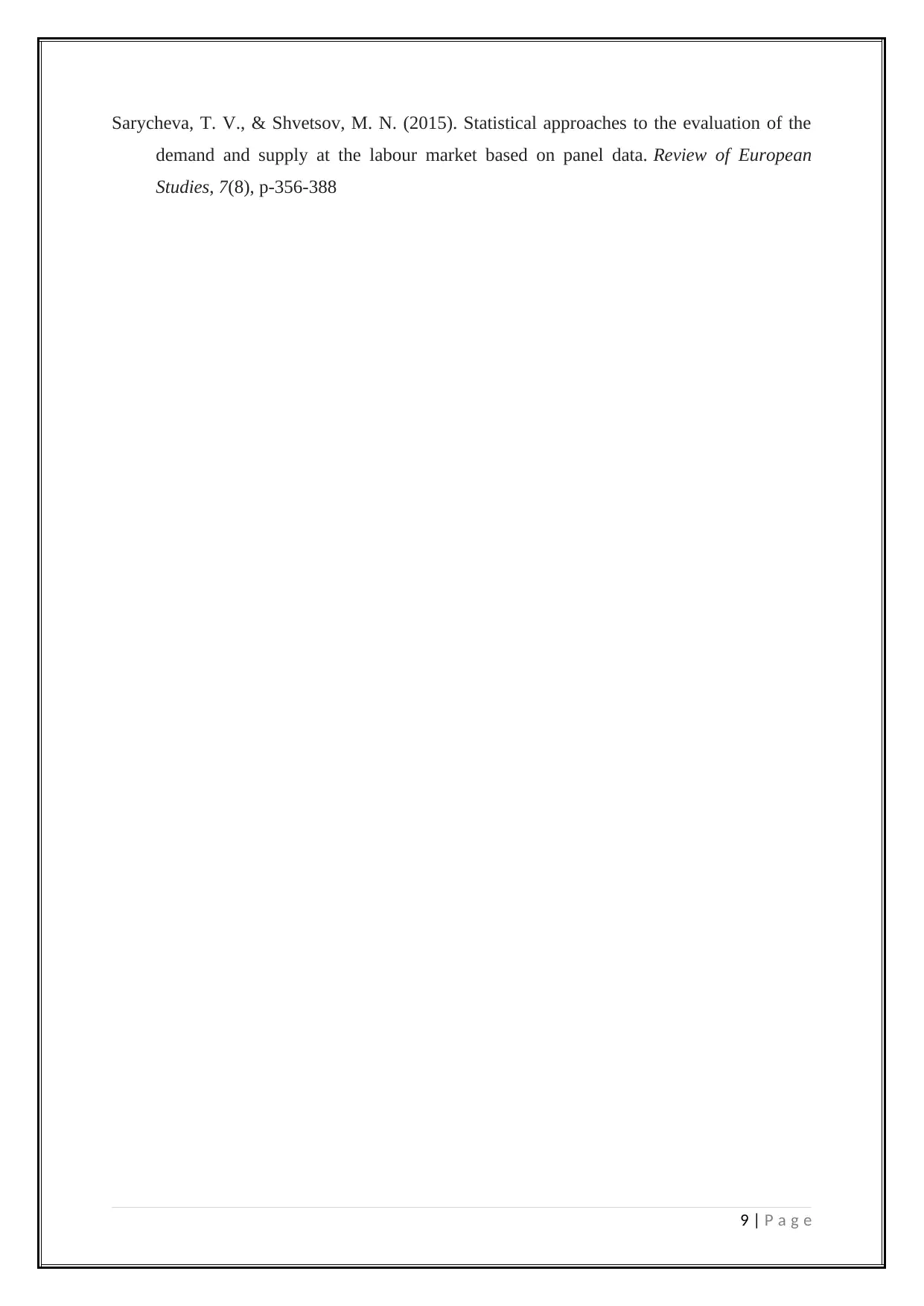
Sarycheva, T. V., & Shvetsov, M. N. (2015). Statistical approaches to the evaluation of the
demand and supply at the labour market based on panel data. Review of European
Studies, 7(8), p-356-388
9 | P a g e
demand and supply at the labour market based on panel data. Review of European
Studies, 7(8), p-356-388
9 | P a g e
⊘ This is a preview!⊘
Do you want full access?
Subscribe today to unlock all pages.

Trusted by 1+ million students worldwide
1 out of 9
Related Documents
Your All-in-One AI-Powered Toolkit for Academic Success.
+13062052269
info@desklib.com
Available 24*7 on WhatsApp / Email
![[object Object]](/_next/static/media/star-bottom.7253800d.svg)
Unlock your academic potential
Copyright © 2020–2025 A2Z Services. All Rights Reserved. Developed and managed by ZUCOL.




